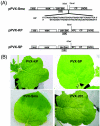Production of an engineered killer peptide in Nicotiana benthamiana by using a potato virus X expression system
- PMID: 16204558
- PMCID: PMC1265961
- DOI: 10.1128/AEM.71.10.6360-6367.2005
Production of an engineered killer peptide in Nicotiana benthamiana by using a potato virus X expression system
Abstract
The decapeptide killer peptide (KP) derived from the sequence of a single-chain, anti-idiotypic antibody acting as a functional internal image of a microbicidal, broad-spectrum yeast killer toxin (KT) was shown to exert a strong microbicidal activity against human pathogens. With the aim to exploit this peptide to confer resistance to plant pathogens, we assayed its antimicrobial activity against a broad spectrum of phytopathogenic bacteria and fungi. Synthetic KP exhibited antimicrobial activity in vitro towards Pseudomonas syringae, Erwinia carotovora, Botrytis cinerea, and Fusarium oxysporum. KP was also expressed in plants by using a Potato virus X (PVX)-derived vector as a fusion to the viral coat protein, yielding chimeric virus particles (CVPs) displaying the heterologous peptide. Purified CVPs showed enhanced antimicrobial activity against the above-mentioned plant pathogens and human pathogens such as Staphylococcus aureus and Candida albicans. Moreover, in vivo assays designed to challenge KP-expressing plants (as CVPs) with Pseudomonas syringae pv. tabaci showed enhanced resistance to bacterial attack. The results indicate that the PVX-based display system is a high-yield, rapid, and efficient method to produce and evaluate antimicrobial peptides in plants, representing a milestone for the large-scale production of high-added-value peptides through molecular farming. Moreover, KP is a promising molecule to be stably engineered in plants to confer broad-spectrum resistance to phytopathogens.
Figures






Similar articles
-
In planta production of two peptides of the Classical Swine Fever Virus (CSFV) E2 glycoprotein fused to the coat protein of potato virus X.BMC Biotechnol. 2006 Jun 22;6:29. doi: 10.1186/1472-6750-6-29. BMC Biotechnol. 2006. PMID: 16792815 Free PMC article.
-
Expression of antimicrobial peptides thanatin(S) in transgenic Arabidopsis enhanced resistance to phytopathogenic fungi and bacteria.Gene. 2013 Sep 15;527(1):235-42. doi: 10.1016/j.gene.2013.06.037. Epub 2013 Jun 29. Gene. 2013. PMID: 23820081
-
Production of a de-novo designed antimicrobial peptide in Nicotiana benthamiana.Plant Mol Biol. 2013 Feb;81(3):259-72. doi: 10.1007/s11103-012-9996-9. Epub 2012 Dec 16. Plant Mol Biol. 2013. PMID: 23242916
-
Engineered killer mimotopes: new synthetic peptides for antimicrobial therapy.Curr Med Chem. 2004 Jul;11(13):1793-800. doi: 10.2174/0929867043364964. Curr Med Chem. 2004. PMID: 15279582 Review.
-
Antifungal and antimicrobial proteins and peptides of potato (Solanum tuberosum L.) tubers and their applications.Appl Microbiol Biotechnol. 2019 Jul;103(14):5533-5547. doi: 10.1007/s00253-019-09887-9. Epub 2019 May 29. Appl Microbiol Biotechnol. 2019. PMID: 31144014 Review.
Cited by
-
Antibodies as an unlimited source of anti-infective, anti-tumour and immunomodulatory peptides.Sci Prog. 2014;97(Pt 3):215-33. doi: 10.3184/003685014X14049273183515. Sci Prog. 2014. PMID: 25549407 Free PMC article. Review.
-
Plant heat shock protein 70 as carrier for immunization against a plant-expressed reporter antigen.Transgenic Res. 2011 Apr;20(2):331-44. doi: 10.1007/s11248-010-9418-1. Epub 2010 Jun 18. Transgenic Res. 2011. PMID: 20559870
-
Use of a PTGS-MAR expression system for efficient in planta production of bioactive Arabidopsis thaliana plant defensins.Transgenic Res. 2007 Aug;16(4):531-8. doi: 10.1007/s11248-006-9057-8. Epub 2006 Dec 19. Transgenic Res. 2007. PMID: 17180735
-
Mycoviruses: future therapeutic agents of invasive fungal infections in humans?Eur J Clin Microbiol Infect Dis. 2010 Jul;29(7):755-63. doi: 10.1007/s10096-010-0946-7. Epub 2010 May 2. Eur J Clin Microbiol Infect Dis. 2010. PMID: 20437251 Review.
-
Microbial Nanoparticles in Biological Plant Protection.Int J Mol Sci. 2025 Mar 11;26(6):2492. doi: 10.3390/ijms26062492. Int J Mol Sci. 2025. PMID: 40141136 Free PMC article. Review.
References
-
- AbouHaidar, M. G., H. Xu, and K. L. Hefferon. 1998. Potexvirus isolation and RNA extraction. Methods Mol. Biol. 81:131-143. - PubMed
-
- Allefs, S. J. H. M., E. R. DeJong, D. E. A. Florack, C. Hoogendoorn, and W. J. Stiekema. 1996. Erwinia soft rot resistance of potato cultivars expressing antimicrobial peptide tachyplesin I. Mol. Breeding 2:97-105.
-
- Avesani, L., A. Falorni, G. B. Tornelli, C. Marusic, A. Porceddu, A. Polverari, C. Faleri, F. Calcinaro, and M. Pezzetti. 2003. Improved in planta expression of the human islet autoantigen glutamic acid decarboxylase (GAD65). Transgenic Res. 12:203-212. - PubMed
-
- Baratova, L. A., N. I. Grebenshchikov, E. N. Dobrov, A. V. Gedrovich, I. A. Kashirin, A. V. Shishkov, A. V. Efimov, L. Jarvekulg, Y. L. Radavsky, and M. Saarma. 1992. The organization of potato virus X coat proteins in virus particles studied by tritium planigraphy and model building. Virology 188:175-180. - PubMed
-
- Baulcombe, D. C., S. Chapman, and S. Santa Cruz. 1995. Jellyfish green fluorescent protein as a reporter for virus infections. Plant J. 7:1045-1053. - PubMed
Publication types
MeSH terms
Substances
LinkOut - more resources
Full Text Sources
Other Literature Sources
Molecular Biology Databases

